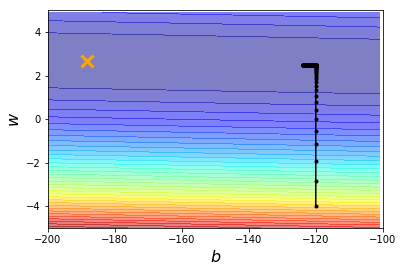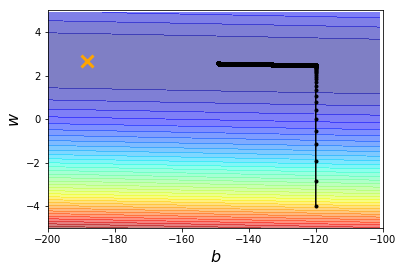ML Lecture 1: Regression - Demo
Gradient Descent Demo
用Python实现梯度下降法求解最优参数 和 。沿用上一节的第一个线性模型:
定义损失函数:
其中, 是第 只pokemon进化后的
真实CP值,
是第
只pokemon进化后的模型
预测CP值。
令损失函数
分别对参数
、
求偏导:
则梯度下降法的求解过程如下:
- 选取参数初始值 、 ,设定一个学习率
- 参数迭代更新的公式为:
用Python代码实现如下:
import numpy as np
import matplotlib.pyplot as plt
# 输入10只pokemon进化前的CP值x_data和进化后的CP值y_data
x_data = [338, 333, 328, 207, 226, 25, 179, 60, 208, 606]
y_data = [640, 633, 619, 393, 428, 27, 193, 66, 226, 1591]
# 模型为y_data = b + w * x_data
# 事实上参数w和b有闭式解(Closed Form Solution),有更简洁的求解方法
# 这里主要是为了练习使用梯度下降法
x = np.arange(-200, -100) # x是横坐标(参数b)的范围
y = np.arange(-5, 5, 0.1) # y是纵坐标(参数w)的范围
Z = np.zeros((len(x), len(y))) # Z是填充0值的array,有len(x)行,有len(y)列
X, Y = np.meshgrid(x, y) # 生成二维空间的网格矩阵,X、Y均是有len(y)行、len(x)列的array
for i in range(len(x)):
for j in range(len(y)):
b = x[i] # 参数b从向量x中取值
w = y[j] # 参数w从向量y中取值
Z[j][i] = 0 # 平方损失值的初始值为0
for n in range(len(x_data)): # 每一个样本的平方损失值累加,共n个样本
Z[j][i] += (y_data[n] - b - w * x_data[n]) ** 2
Z[j][i] = Z[j][i] / len(x_data) # 总平方损失值/n
# 设置初始参数
b = -120 # 参数b的初始值
w = -4 # 参数w的初始值
lr = 0.0000001 # 设置学习率
iteration = 100000 # 设置迭代次数
# 用2个列表分别储存2个参数的初始值
b_history = [b]
w_history = [w]
# 参数迭代更新过程
for i in range(iteration):
b_grad = 0.0 # 参数b的初始偏导值为0
w_grad = 0.0 # 参数w的初始偏导值为0
for n in range(len(x_data)):
b_grad -= 2.0 * (y_data[n] - b - w * x_data[n]) * 1.0 # 参数b的偏导公式
w_grad -= 2.0 * (y_data[n] - b - w * x_data[n]) * x_data[n] # 参数w的偏导公式
# 加入学习率后更新的参数
b = b - lr * b_grad
w = w - lr * w_grad
# 保存更新的参数
b_history.append(b)
w_history.append(w)
# 画图
plt.contourf(x, y, Z, 50, alpha=0.5, cmap=plt.get_cmap('jet'))
plt.plot([-188.4], [2.67], 'x', ms=12, markeredgewidth=3, color='orange')
plt.plot(b_history, w_history, 'o-', ms=3, lw=1.5, color='black')
plt.xlim(-200, -100)
plt.ylim(-5, 5)
plt.xlabel(r'$b$', fontsize=16)
plt.ylabel(r'$w$', fontsize=16)
plt.show()作出如下图一,黑色线代表参数求解的迭代路径。假设我们已经知道实际最优解的位置在橘色叉叉 处,现在考察用梯度下降法求解出来的参数,与这个实际最优解 相差多大。图一中,我们设定初始参数的出发位置为 ,学习率为 ,迭代次数为 次,解得参数 ,这个解与实际最优解相差很远。
图一:lr=0.0000001,iteration=100000,(b,w)=(-123.69,2.48)

为了求得最佳参数,尝试使迭代次数保持不变( 次),学习率分别增大10倍,设为 、 。
图二:lr=0.000001,iteration=100000,(b,w)=(-149.23, 2.56)

图三:lr=0.00001,iteration=100000,(b,w)=(nan,nan)

图三学习率过大,严重偏离最优解的迭代路径,参数已经变成NA值。
故尝试使学习率保持不变(
),迭代次数分别设为
、
。图五可见迭代效果不错,但迭代次数很大。
图四:lr=0.0000001,iteration=1000000,(b,w)=(-149.23,2.56)

图五:lr=0.0000001,iteration=10000000,(b,w)=(-188.17,2.67)

Adagrad优化算法
虽然图五通过增加迭代次数,逐渐逼近最优参数,但是运行的时间也相应增加。考虑用Adagrad优化算法:在迭代过程中,分别对参数
、
指定客制化的学习率。
import numpy as np
import matplotlib.pyplot as plt
x_data = [338, 333, 328, 207, 226, 25, 179, 60, 208, 606]
y_data = [640, 633, 619, 393, 428, 27, 193, 66, 226, 1591]
x = np.arange(-200, -100)
y = np.arange(-5, 5, 0.1)
Z = np.zeros((len(x), len(y)))
X, Y = np.meshgrid(x, y)
for i in range(len(x)):
for j in range(len(y)):
b = x[i]
w = y[j]
Z[j][i] = 0
for n in range(len(x_data)):
Z[j][i] += (y_data[n] - b - w * x_data[n]) ** 2
Z[j][i] = Z[j][i] / len(x_data)
b = -120
w = -4
lr = 1 # 学习率随便设为1
iteration = 100000
b_history = [b]
w_history = [w]
lr_b = 0 # 参数b的初始学习率为0
lr_w = 0 # 参数w的初始学习率为0
for i in range(iteration):
b_grad = 0.0
w_grad = 0.0
for n in range(len(x_data)):
b_grad -= 2.0 * (y_data[n] - b - w * x_data[n]) * 1.0 # L对参数b的偏导值
w_grad -= 2.0 * (y_data[n] - b - w * x_data[n]) * x_data[n] # L对参数w的偏导值
# 偏导数累加
lr_b = lr_b + b_grad ** 2
lr_w = lr_w + w_grad ** 2
# 用Adagrad的学习率更新参数
b = b - lr/np.sqrt(lr_b) * b_grad
w = w - lr/np.sqrt(lr_w) * w_grad
b_history.append(b)
w_history.append(w)
plt.contourf(x, y, Z, 50, alpha=0.5, cmap=plt.get_cmap('jet'))
plt.plot([-188.4], [2.67], 'x', ms=12, markeredgewidth=3, color='orange')
plt.plot(b_history, w_history, 'o-', ms=3, lw=1.5, color='black')
plt.xlim(-200, -100)
plt.ylim(-5, 5)
plt.xlabel(r'$b$', fontsize=16)
plt.ylabel(r'$w$', fontsize=16)
plt.show()
解得最优参数为 。
相关Python函数
range(start, stop, step)
# 起始值为start(默认从0开始),结束值为stop(不包括stop本身),step为间距
# 结果生成一个range对象,而不是一个数值序列
[In]: range(5) == range(0, 5)
[Out]: True
[In]: c = [i for i in range(5)];print(c)
[Out]: [0, 1, 2, 3, 4]
import numpy as np
np.arange(start, stop, step)
# 起始值为start(默认从0开始),结束值为stop(不包括stop本身),step为间距
# 结果生成一个array,数值序列
[In]: x = np.arange(0, 2);y = np.arange(0, 5);print(x);print(y)
[Out]:
[0 1]
[0 1 2 3 4]
np.zeros(shape, dtype=float, order='C')
# 参数shape为数值或数值序列,设定array的形状
# 参数dtype表示数据类型,默认numpy.float64;参数order可选'C'(行优先)或'F'(列优先)
# 返回一个填充0值的array
[In]: np.zeros(shape=(2,5))
[Out]:
array([[0., 0., 0., 0., 0.],
[0., 0., 0., 0., 0.]])
# 生成2×5的array
np.meshgrid(x, y)
# 参数x和y是一维向量,x中的值作为横坐标(做竖向扩展),y中的值作为纵坐标(做横向扩展)
# 结果返回一个坐标矩阵(网格矩阵)
[In]: x = np.arange(0, 2);y = np.arange(0, 5);print(x);print(y)
[Out]:
[0 1]
[0 1 2 3 4]
[In]: X, Y = np.meshgrid(x, y);print(X);print(Y)
[Out]:
[[0 1]
[0 1]
[0 1]
[0 1]
[0 1]]
[[0 0]
[1 1]
[2 2]
[3 3]
[4 4]]
# X、Y均是5×2的array
# 可见,向量x竖向扩展了len(y)次,向量y横向扩展了len(x)次,X和Y这两个array的行列数是相同的